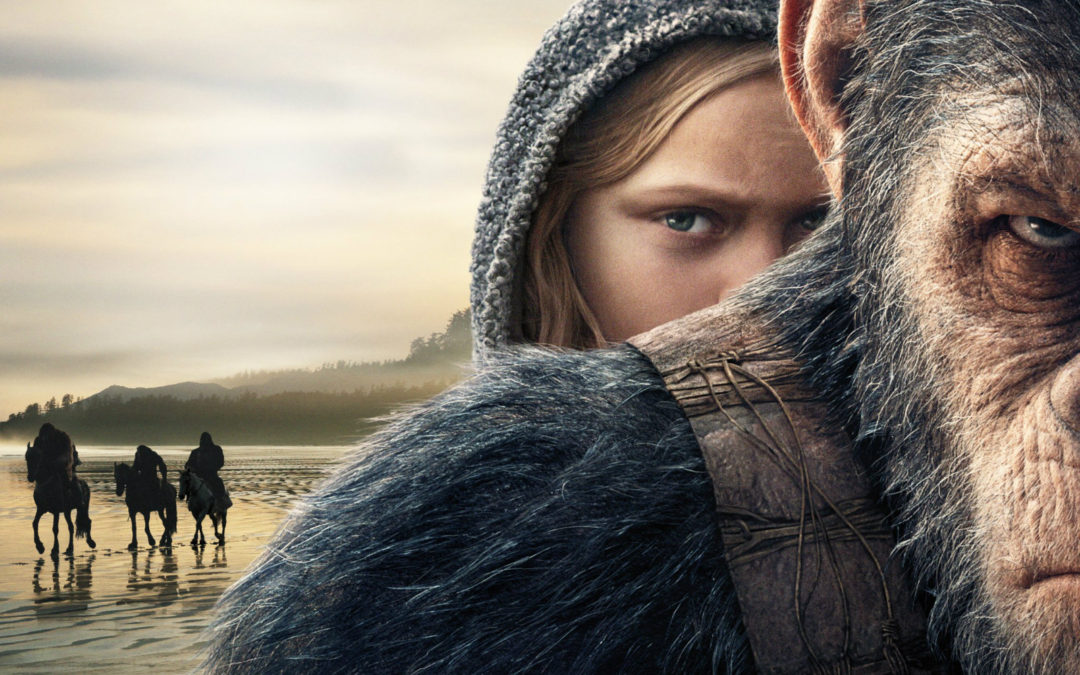THE MOVIE THEATER — Back in 2011, 20th Century Fox released “Rise of the Planet of the Apes.”
“Rise” was Fox’s second attempt at rebooting the Apes series, after the misguided efforts of Tim Burton’s 2001 project. Rumors suggested the new story was a confusing mix of both remake and prequel, leaving many fans with reasonably low expectations.
But as it turned out, “Rise” was actually good. Sure, the CGI was off a bit and James Francois a love-him-or-hate-him kind of guy, but critics mostly agreed director Rupert Wyatt had created something special. In fact, “Rise” was interesting enough that people didn’t even ask how it tied into the originals. “Rise” had become the “Batman Begins” of talking monkey movies, and its sequel, “Dawn of the Planet of the Apes,” became the rare follow-up that was as good, or better, than its predecessor.
Which brings us to this weekend’s “War for the Planet of the Apes” — the third and final installment of Caesar’s trilogy.
Where “Rise” was met with low expectations and modest interest, fans are hoping “War” is a worthy sendoff to characters they’ve grown to love.
Does “War” deliver? Is it possible that Fox saved the best Ape movie for last?
Like always, let’s talk about the highlights:
The Premise
Two years after the events of “Dawn of the Planet of the Apes,” apes and humans continue their war as mankind heads toward the edge of extinction. Caesar (Andy Serkis), leader of the apes, searches for a peaceful solution to the fighting until humans invade Caesar’s camp, beginning a personal feud between Caesar and The Colonel (Woody Harrelson) — leader of one of the remaining human colonies.
As Caesar begins letting revenge cloud his judgment, he recognizes how similar he has become to Koba, the bonobo who caused the events of “Dawn,” forcing him to question his worthiness as the future leader of the ape community.
Trilogy finales
Very few movie trilogies deliver a satisfying final chapter.
Even when trilogies end well, elements like Ewoks and countdown clocks tend to creep into the final product, making it difficult for audiences to say, “They saved the best for last.” However, with “War,” many fans will walk away saying just that.
“War for Planet of the Apes” is a slow-roasted, character-driven story that examines the frailty of good intentions. While Caesar has been consistent with his ideals through chapters 1 and 2, “War” tangles Caesar into a position where separating what’s best for his followers from his personal ambitions is an almost impossible task. This allows the story to build on the already compelling themes from “Rise” and “Dawn,” while also lending audiences additional insight into their favorite chimpanzee protagonist.
CG protagonists
It’s impossible to discuss movies with CG protagonists without eventually touching on the effects.
Yes, everyone is going to tell you the New Zealand effects house, Weta, hit a homerun with “War’s” performance transfers and seamless real-world interaction, and yes, everyone will be correct when they tell you there are shots where you can’t tell the difference between reality and computer graphics. That is all true. But if you’re expecting a feature-length, photorealistic experience with talking monkeys, “War” isn’t going to be the movie historians point to and say, “That’s the one. That’s the movie where we bridged uncanny valley.”
What historians probably will say, however, is “War” was another significant step forward. “War” gets major credit for being a movie that swings for the fences when it comes to serious, noncartoony CG characters, and lands with significantly more success than say, that Tarkin character from “Rogue One.” But at the end of the day, there are still several scenes that will pull you back into reality for a few seconds as you adjust to the fact that you’re cheering for almost-lifelike monkey characters.
The Apes universe
Now that we’ve seen Fox’s vision for the new Apes series, we can speak to where and how the new films fit in with the original series.
Up until now, it’s seemed “Rise” was replacing 1972s “Conquest of the Planet of the Apes,” and audiences were to assume anything after the weirdness that was 1970s “Beneath the Planet of the Apes” never actually happened. But after seeing “War,” it’s reasonable to say “Rise” is simply the first movie of the series.
If you had absolutely nothing to do one weekend, you could begin with “Rise,” “Dawn” and “War,” before letting the original series play out in its entirety (sans that Burton film). It would be strange for sure, but it would make sense — I mean, Planet of the Apes sense. We would still be dealing with the same movies that brought us time-traveling monkey parents and telepathic bomb-worshiping humans. You would also need to accept that the events that take place in “Escape from the Planet of the Apes” reshape the future current films, but again, you’ve already accepted the telepathic bomb-worshipping humans.
You can read my entire overview of the series before starting your Planet of the Apes marathon here, but at the end of the day, Fox earns a high-five for successfully achieving both remake and prequel status with its latest trilogy.
Conclusion
The previous Planet of the Apes remakes set a high bar for this weekend’s “War for the Planet of the Apes,” and “War” sails over it with patience and purpose.
Writer and director Matt Reeves really did have a reason to continue Caesar’s story, and while that reason is twisted in heavy themes and ugly circumstance, Reeves concludes this third chapter with a message of hope worthy of the beloved leader.

